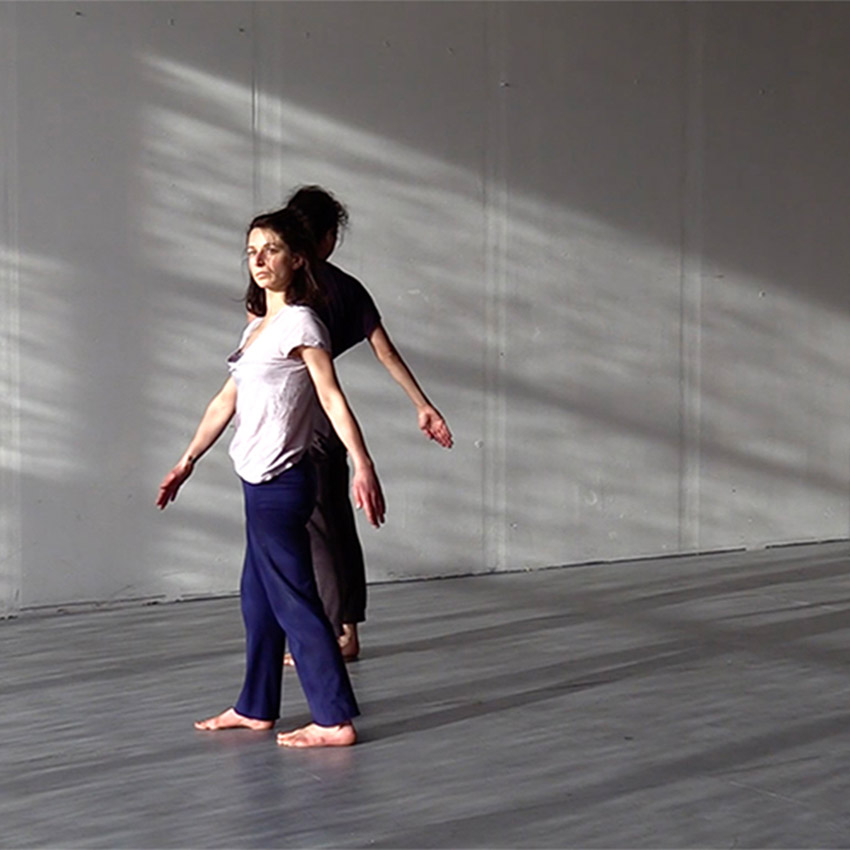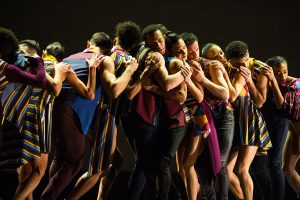
© Claire Duplantier. (Click image for larger version)
Aura Fischbeck Dance
DUSK
★★★✰✰
San Francisco, Joe Good Annex
9 November 2018
www.aurafischbeckdance.org
joegoode.org/joe-goode-annex
As I headed into San Francisco for the world premiere of Aura Fischbeck Dance’s DUSK, the sun glowing red because of the wildfires to the north, it struck me that I had never been to a Friday performance that began at 4:30 in the afternoon. This was a first. Though considering the inspiration for the new dance piece, the early start made absolute sense. Choreographed by Aura Fischbeck for the company’s tenth home season, DUSK looks to that time lapse when the day disappears and the night dawns. It’s part of the day that I don’t often think about. I’m aware it’s happening of course, but it’s rarely pulling my attention or focus. After seeing this thoughtful, nuanced show, I’ll surely be much more mindful of the shift.
DUSK had a lot going for it. First was the overall concept. DUSK challenges the viewer to not only acknowledge the idea of transformation, but to consider what lies beneath. To that end, the all-female quartet (Arletta Anderson, Fischbeck, Phoenicia Pettyjohn and Karla Quintero) choreographically unpacked multiple themes around change throughout the work – themes of transitional space; themes of altered visibility; themes of simultaneous, yet opposing forces.

© Mark McBeth – still from video. (Click image for larger version)
As DUSK began, the cast cycled through a series of cluster shapes on the ground. Slowly, they arranged and re-arranged themselves into tableaux after tableaux, limbs circling upward and outward to move from one form to the next. Unhurried, the dancers luxuriated in the pathway that each arm or leg took. In doing so, they communicated that the journey, the transition, was just as important and interesting as the final shape or posture. Perhaps even more, DUSK also played with the viewership lens. At several points, dancers moved through phrases while facing away from the audience; their gestures a crafty mystery to those present. Or in another instance, the four lay on the ground writing feverishly with one hand while the other hand shielded the thoughts and intentions from everyone else. These purposeful comments on visibility prompted deeper thinking and questioning. As dusk progresses, things that were discernible can become somewhat hidden. It’s a phenomenon that is completely out of one’s control. Where else is this mirrored in life? Is the visual limitation okay or bothersome? Is it neither? DUSK invited each viewer to reach their own conclusion. Oppositional forces, akin to dusk’s blend of light and dark, were also mined and explored. Super fast boureés on the knees were combined with a calming upper body; pulsing, frenetic palms were paired with steady articulations of the feet. Over and over again, Anderson ran from one corner of the space to another; her feet and legs moving at top speed while her arms gently and quietly wafted like wings. Watching all of this transpire while dusk was falling outside, visible through a wall of windows, made for a layered, immersive experience.
DUSK’s second triumph was its choreographic vocabulary. I was pretty jazzed to see an entire piece that wasn’t jam packed with choreographic inversion, which is becoming the norm in SF. Or maybe it’s more accurate to say that it’s the overwhelming physical trend right now. In any event, so many dancemakers are using inverted movement vocabulary and using it a lot. The unintended result is that dances are looking awfully similar; they are really starting to blend together. DUSK stood out as different. Referencing syntax from some of the modern masters, it was a choreographic breath of fresh air. Flowy, lilty arms and triplets conjured Duncan; upper body curves, arched shapes and rebounding jumps spoke of Limón; sharp, diagonal positions and gooey layouts screamed Graham. I miss these styles of movement, and was heartened to see that they haven’t disappeared from the SF contemporary dance landscape altogether.

© Mark McBeth – still from video. (Click image for larger version)
Third, the piece had a surprising dynamic arc. When I think of the transition from daytime to night, I imagine an energetic flow that is gradually declining – the energy and bustle of the day giving way to a more serene and restful state. Fischbeck turned that assumption on its head, and posited the exact opposite. DUSK’s first third, when it was still light outside, had a meditative, tranquil quality. As the dance progressed, and it got darker, the energy actually picked up and built. It wasn’t at all what I was expecting, and I love it when dance upends my preconceptions.
Length and sound were both areas where DUSK faced some challenges. Unlike many evening-length contemporary dances, DUSK did not unfold like a series of scenes. Instead, it was a choreographic stream of consciousness – all four dancers were onstage for the entire work. I quite liked this format, but I don’t know that it needed to be almost an hour long. And while there was much choreographic material to keep one engaged, there was also plenty of repetition. I think some of it could have been pruned. For the most part, Alex Lough’s original score, with its ambient musical motifs and echo-y chords, really matched DUSK’s mood and concept. That is, save for one lengthy section where the atmospheric composition faded away and an odd staccato-esque sound collage took over. It didn’t fit. Also in the sound camp, from time to time the cast vocalized onstage with hushing sounds and singing. While I wouldn’t say this was distracting, I also wouldn’t say that it added anything to the work.

















You must be logged in to post a comment.